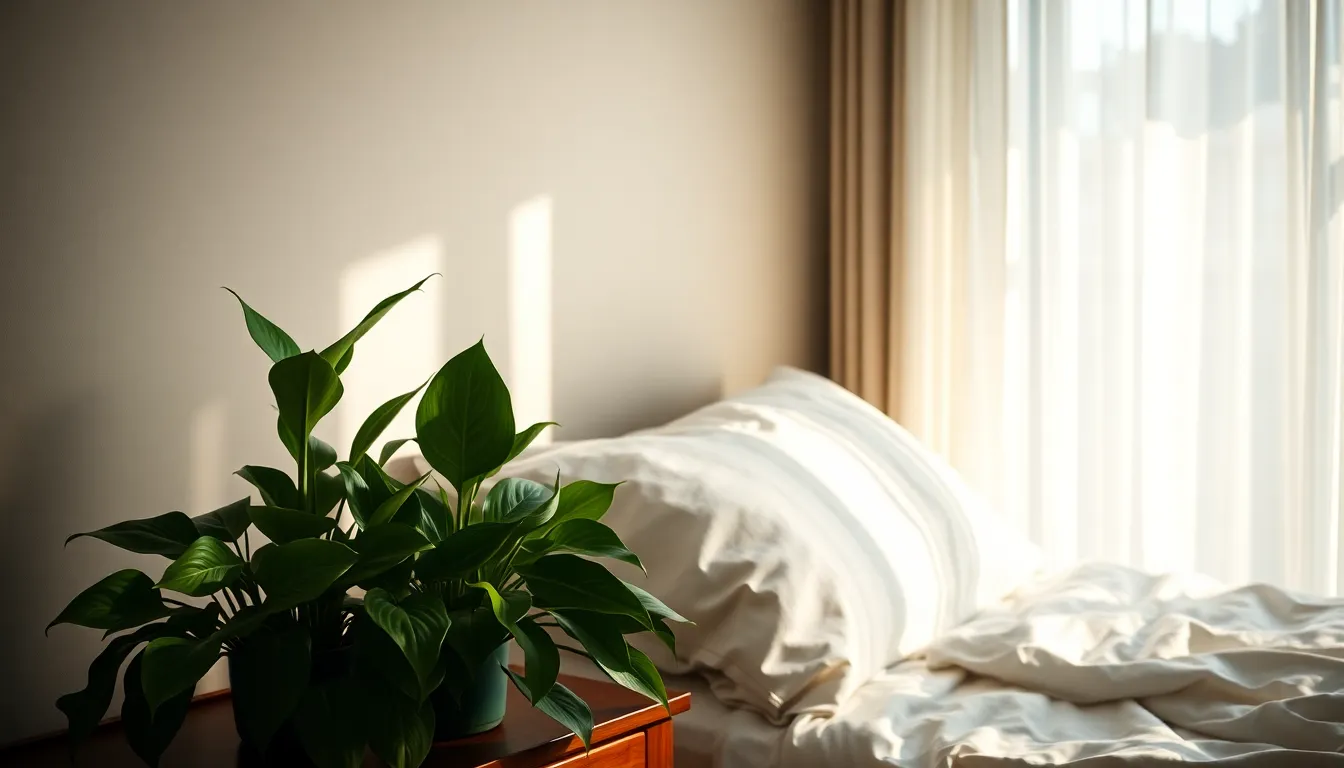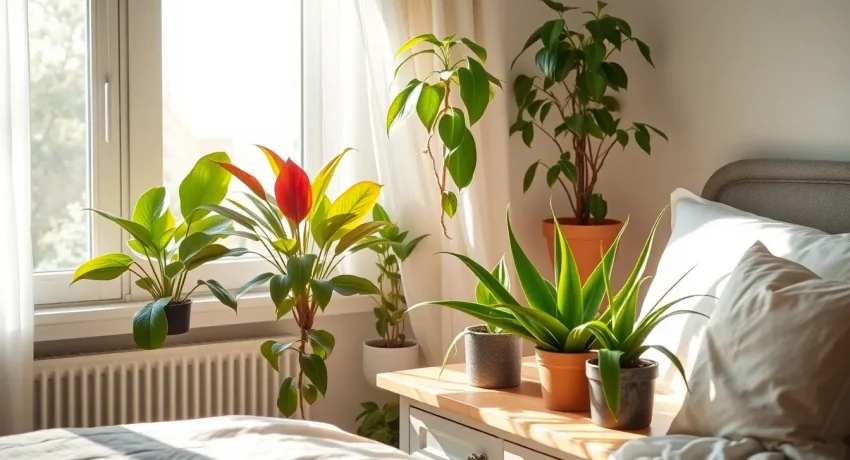Imagine waking up to a room that feels like a mini jungle, where the air is crisp and the vibe is just right. Bedroom plants aren’t just trendy; they’re like little green superheroes fighting off bad vibes and stale air. These leafy companions can boost mood, improve sleep, and even make you feel like a botanical wizard with minimal effort.
Whether you’re a seasoned plant parent or just starting to dip your toes into the world of indoor gardening, the right plants can transform your space. From low-maintenance succulents that thrive on neglect to lush ferns that practically scream, “I’m alive!” there’s a perfect plant for everyone. So, let’s dive into the leafy goodness and discover how these bedroom buddies can elevate your sanctuary while keeping your air fresh and your spirits high.
Table of Contents
ToggleOverview of Bedroom Plants
Bedroom plants play a vital role in enhancing the indoor environment. These plants not only beautify the space but also contribute to improved air quality. Studies indicate that certain plants can filter toxins, providing a healthier sleep environment.
Among popular choices, snake plants thrive in low light, making them perfect for bedrooms. Peace lilies require minimal care yet deliver stunning blooms. They also effectively remove harmful chemicals, enhancing indoor air purity.
Aloe vera offers dual benefits. It serves as a decorative element while boasting medicinal properties, ideal for treating minor burns and skin irritations. Lavender plants, known for their soothing scent, can promote relaxation, aiding restful sleep.
Ferns, particularly Boston ferns, add lush greenery and require consistent humidity. They thrive best in bathrooms but can also adapt well in bedrooms with proper care. Spider plants feature spider-like offshoots, adding charm while being resilient and easy to maintain.
Cacti require minimal watering, making them suitable for busy lifestyles. They come in various shapes and sizes, offering unique aesthetic options. For individuals seeking vibrant flowers, hibiscus plants can introduce color and texture.
Ultimately, the selection of bedroom plants depends on personal preferences and care commitments. Each plant provides distinct advantages, ranging from air purification to aesthetic appeal. The right choice can transform a bedroom into a peaceful sanctuary.
Benefits of Bedroom Plants

Bedroom plants offer significant advantages, enhancing both environment and well-being. These plants not only beautify spaces but also contribute to a healthier lifestyle.
Air Purification
Plants like snake plants and peace lilies excel at filtering toxins from the air. They absorb harmful substances, improving indoor air quality. Studies show that indoor plants can reduce levels of formaldehyde, benzene, and other pollutants. Spider plants also aid in purifying air, making spaces healthier for breathing. Placing these plants in the bedroom can lead to less exposure to allergens, creating a more serene atmosphere. Enhanced air quality can support better sleep and overall health.
Psychological Well-being
Introducing greenery into the bedroom promotes mental well-being. Studies indicate that houseplants can reduce stress and anxiety levels. They stimulate positive emotions and boost mood through their natural aesthetic. Interacting with plants fosters a sense of responsibility and belonging. Lavender, in particular, is known for its calming scent, which aids relaxation and sleep quality. Experiencing nature indoors helps individuals feel connected, enhancing their psychological state even within their personal spaces.
Best Bedroom Plants
Choosing the right plants can significantly enhance a bedroom’s ambiance. Several options cater to various preferences and light conditions.
Low-Light Options
Snake plants thrive in low light and require minimal watering. ZZ plants tolerate neglect while adding lush greenery. Pothos offers elegant trailing vines, perfect for shelves and hanging baskets. These plants not only beautify the space but also purify the air, making them ideal for improving indoor environments. Peace lilies flourish in shaded spots while providing white blooms for visual interest. Cast iron plants are robust, enduring neglect and varying light conditions with grace. Selecting any of these options ensures a vibrant and healthy atmosphere even when natural light is scarce.
Fragrant Plants
Lavender fills bedrooms with its calming scent, promoting relaxation and better sleep. Jasmine, known for its sweet fragrance, can help reduce anxiety and enhance mood. Gardenias add both beauty and aroma, making spaces feel inviting. Scented geraniums bring a unique fragrance while attracting beneficial insects. Incorporating any of these fragrant plants transforms the sleeping area into a soothing sanctuary. These choices enhance air quality while providing sensory pleasure, making bedroom environments more enjoyable and restful.
Care Tips for Bedroom Plants
Caring for bedroom plants involves understanding their specific needs. Successful growth depends on proper watering and light exposure.
Watering Needs
Watering practices vary among different plants. Snake plants thrive with infrequent watering, while peace lilies require consistent moisture. A general rule involves checking the top inch of soil; if it’s dry, it’s time to water. Overwatering can lead to root rot, so ensuring pots have drainage holes is crucial. Cacti need even less water, often just once every few weeks. Adjusting watering schedules based on seasonal changes improves plant health.
Light Requirements
Light conditions play a significant role in plant vitality. Low-light plants like ZZ plants and pothos flourish in shaded areas. Conversely, plants that require bright, indirect sunlight, such as lavender, perform best near windows. Placing plants in correct light will enhance their growth and prevent leggy stems. Rotating plants every few weeks promotes even growth and exposure. Observing each plant’s response helps to identify its ideal light conditions.
Common Challenges with Bedroom Plants
Managing bedroom plants comes with its own set of challenges. Recognizing these challenges helps ensure a thriving indoor garden.
Pests and Diseases
Pests can quickly ruin a bedroom plant’s health. Common pests include spider mites and aphids, which often appear on the leaves. Routine inspections are crucial; they enable early detection of infestations. Diseases, such as root rot or leaf spot, can develop due to poor watering practices or insufficient air circulation. Healthy plants are more resilient against these threats. Maintaining proper humidity levels and airflow contributes to their overall strength. Treatment methods vary; introducing natural predators can help manage pests, while removing affected leaves often prevents disease spread. Applying organic insecticides also offers a safe solution to control infestations.
Choosing the Right Pot
Selecting an appropriate pot influences a bedroom plant’s growth. Drainage holes are essential; they prevent excess water retention and root rot. Pot materials matter too; terracotta or ceramic offers breathability compared to plastic options. Consider the plant’s size; pots should allow for growth without being overcrowded. Transplanting into a larger pot becomes necessary as plants mature, ensuring sufficient space for root expansion. Interior aesthetics also play a role; decorative pots can enhance the overall décor while housing the plants. Lastly, choosing the right potting mix aligns with individual plant needs, fostering optimal health and development.
Integrating bedroom plants into living spaces can significantly enhance both well-being and aesthetics. By choosing the right plants, individuals can create a calming environment that supports relaxation and rejuvenation. The benefits extend beyond mere decoration; these green companions actively improve air quality and contribute to a healthier indoor atmosphere.
With a variety of options available, from low-light succulents to fragrant flowers, it’s easy for anyone to find the perfect fit for their bedroom. Embracing this green lifestyle not only beautifies the space but also fosters a deeper connection to nature, promoting a sense of tranquility and balance in daily life.




